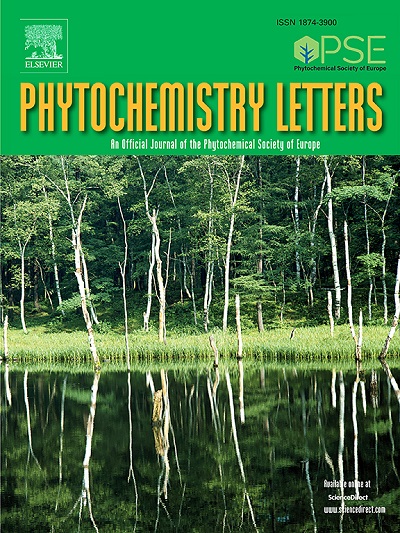(±)-Laevigiol A是一种新的对映体苯丙素,从Croton laevigatus Vahl的叶和枝中分离得到。以及抗阿尔茨海默病的活动
IF 1.4
4区 生物学
Q4 CHEMISTRY, MEDICINAL
引用次数: 0
摘要
(+)-Laevigiol A (1a)和(−)-Laevigiol A (1b)是一对新的对映体苯丙素,与10个已知的化合物(2-11)一起从巴豆叶和嫩枝的乙醇提取物中分离得到。外消旋混合物1采用手性高效液相色谱分离。通过光谱数据分析(IR、hresms、1D和2D NMR)和电子圆二色性(ECD)曲线的量子化学计算,确定了它们具有绝对构型的结构。此外,通过秀丽隐杆线虫AD病理模型,评价了所有化合物的体内抗阿尔茨海默病(AD)活性。其中化合物1、6和9-11可延缓蠕虫麻痹表型的ad样症状,提示其具有潜在的抗ad生物活性。本文章由计算机程序翻译,如有差异,请以英文原文为准。
(±)-Laevigiol A, a pair of new enantiomeric phenylpropanoids from the leaves and twigs of Croton laevigatus Vahl. and their anti-Alzheimer’s disease activities
(+)-Laevigiol A (1a) and (−)-Laevigiol A (1b), a pair of new enantiomeric phenylpropanoids, together with ten known compounds (2–11), were isolated from the ethanol extract of the leaves and twigs of Croton laevigatus. The racemic mixture 1 was separated through chiral HPLC. Their structures with absolute configurations were established by analysis of spectroscopic data (IR, HRESIMS, 1D and 2D NMR) and quantum chemical calculations of electronic circular dichroism (ECD) curves. Furthermore, all compounds were evaluated for their in vivo anti-Alzheimer’s disease (AD) activities by using Caenorhabditis elegans AD pathological model. Among them, compounds 1, 6, and 9–11 could delay AD-like symptoms of worm paralysis phenotype, indicating their potential anti-AD bioactivities.
求助全文
通过发布文献求助,成功后即可免费获取论文全文。
去求助
来源期刊

Phytochemistry Letters
生物-生化与分子生物学
CiteScore
3.00
自引率
11.80%
发文量
190
审稿时长
34 days
期刊介绍:
Phytochemistry Letters invites rapid communications on all aspects of natural product research including:
• Structural elucidation of natural products
• Analytical evaluation of herbal medicines
• Clinical efficacy, safety and pharmacovigilance of herbal medicines
• Natural product biosynthesis
• Natural product synthesis and chemical modification
• Natural product metabolism
• Chemical ecology
• Biotechnology
• Bioassay-guided isolation
• Pharmacognosy
• Pharmacology of natural products
• Metabolomics
• Ethnobotany and traditional usage
• Genetics of natural products
Manuscripts that detail the isolation of just one new compound are not substantial enough to be sent out of review and are out of scope. Furthermore, where pharmacology has been performed on one new compound to increase the amount of novel data, the pharmacology must be substantial and/or related to the medicinal use of the producing organism.
 求助内容:
求助内容: 应助结果提醒方式:
应助结果提醒方式:


